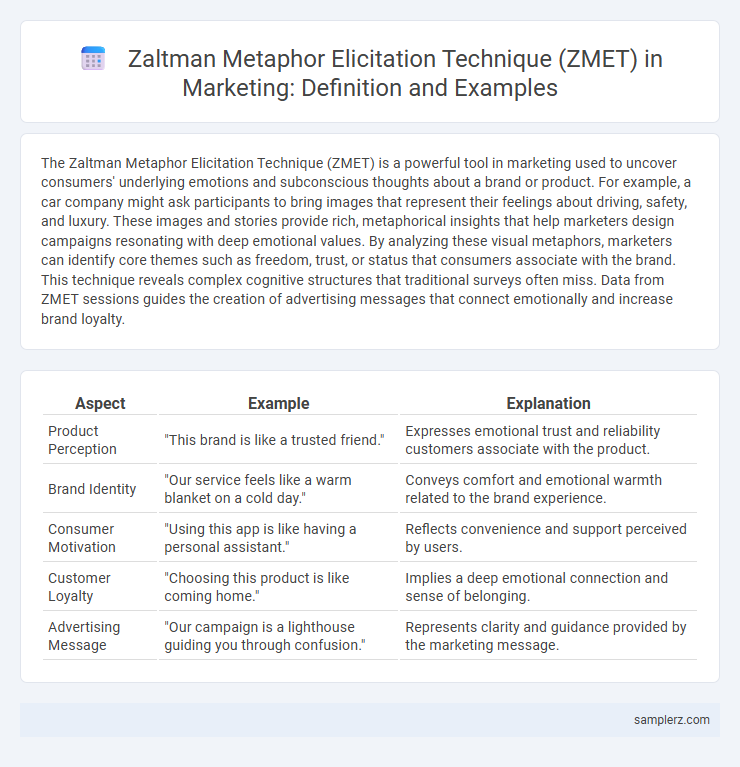The Zaltman Metaphor Elicitation Technique (ZMET) is a powerful tool in marketing used to uncover consumers' underlying emotions and subconscious thoughts about a brand or product. For example, a car company might ask participants to bring images that represent their feelings about driving, safety, and luxury. These images and stories provide rich, metaphorical insights that help marketers design campaigns resonating with deep emotional values. By analyzing these visual metaphors, marketers can identify core themes such as freedom, trust, or status that consumers associate with the brand. This technique reveals complex cognitive structures that traditional surveys often miss. Data from ZMET sessions guides the creation of advertising messages that connect emotionally and increase brand loyalty.
Table of Comparison
| Aspect | Example | Explanation |
|---|---|---|
| Product Perception | "This brand is like a trusted friend." | Expresses emotional trust and reliability customers associate with the product. |
| Brand Identity | "Our service feels like a warm blanket on a cold day." | Conveys comfort and emotional warmth related to the brand experience. |
| Consumer Motivation | "Using this app is like having a personal assistant." | Reflects convenience and support perceived by users. |
| Customer Loyalty | "Choosing this product is like coming home." | Implies a deep emotional connection and sense of belonging. |
| Advertising Message | "Our campaign is a lighthouse guiding you through confusion." | Represents clarity and guidance provided by the marketing message. |
Introduction to the Zaltman Metaphor Elicitation Technique (ZMET)
The Zaltman Metaphor Elicitation Technique (ZMET) uncovers deep consumer insights by using visual metaphors gathered through interviews, enabling marketers to explore subconscious thoughts and emotions. Through a series of structured conversations, participants select images that represent their feelings about a brand or product, revealing underlying perceptions that traditional surveys might miss. This technique enhances brand communication strategies by uncovering hidden mental models influencing consumer behavior.
Understanding the Role of Metaphors in Consumer Behavior
Zaltman Metaphor Elicitation Technique (ZMET) uncovers deep metaphors consumers use to describe brands and products, revealing subconscious feelings and associations that drive purchasing decisions. In marketing, ZMET helps identify emotional connections by analyzing visual and verbal metaphors, guiding more effective brand messaging and product positioning. Understanding these metaphors enables marketers to tailor campaigns that resonate on a psychological level, influencing consumer behavior with greater precision.
Steps Involved in the ZMET Process for Marketing Research
The Zaltman Metaphor Elicitation Technique (ZMET) in marketing research involves a series of steps beginning with participant image collection to uncover subconscious thoughts, followed by in-depth one-on-one interviews where participants describe and interpret their selected images. Researchers then identify common themes and metaphors from transcripts, using visual and verbal data to construct a consensus map representing consumers' mental models. This process reveals deep insights into customer emotions and perceptions, enabling marketers to develop more impactful branding and communication strategies.
Case Study: ZMET Application in the Beverage Industry
Zaltman Metaphor Elicitation Technique (ZMET) was applied in the beverage industry to uncover deep consumer insights by analyzing metaphors related to brand experiences. In one case study, a leading soda company used ZMET to reveal that consumers associated their beverage with concepts of adventure and emotional connection, driving the development of a more targeted advertising campaign. This approach led to a measurable increase in brand loyalty and market share by aligning marketing messages with consumers' subconscious motivations.
Uncovering Hidden Consumer Insights with ZMET
Zaltman Metaphor Elicitation Technique (ZMET) reveals deep, unconscious consumer insights by exploring visual metaphors that represent emotions and thought patterns. Marketing teams use ZMET to decode complex attitudes towards brands, enabling tailored strategies that resonate more authentically with target audiences. This method uncovers latent desires and motivations, enhancing product positioning and communication effectiveness.
ZMET in Branding Strategy Development
Zaltman Metaphor Elicitation Technique (ZMET) uncovers deep consumer insights by revealing subconscious thoughts and emotions through visual storytelling, crucial for branding strategy development. By analyzing participants' metaphors and images, marketers identify underlying brand perceptions and emotional connections, enabling creation of compelling and differentiated brand messages. This approach enhances brand positioning by aligning marketing strategies with consumers' intrinsic motivations and values.
Enhancing Product Innovation through ZMET
The Zaltman Metaphor Elicitation Technique (ZMET) uncovers deep consumer insights by exploring subconscious thoughts through visual metaphors, enabling marketers to identify emotional drivers behind product preferences. Brands leverage ZMET to enhance product innovation by capturing rich, non-verbal consumer perceptions that traditional surveys often miss, leading to more impactful product design and messaging. This approach fosters breakthrough ideas grounded in authentic consumer experiences, improving market fit and brand resonance.
Emotional Connection: ZMET in Advertisement Analysis
Zaltman Metaphor Elicitation Technique (ZMET) uncovers deep emotional connections consumers have with brands by analyzing subconscious metaphors in advertisements. For example, a study using ZMET on Nike ads revealed that consumers associate the brand with personal empowerment and overcoming challenges, symbolized by metaphors like "breaking chains" or "soaring wings." This insight enables marketers to craft emotionally resonant campaigns that strengthen consumer-brand relationships and enhance engagement.
ZMET Success Stories from Leading Brands
Leading brands like Coca-Cola and Procter & Gamble have successfully applied the Zaltman Metaphor Elicitation Technique (ZMET) to uncover deep consumer insights by exploring subconscious metaphors. Coca-Cola utilized ZMET to reshape its advertising strategy, tapping into emotional and cultural imagery that resonated universally and strengthened brand loyalty. Procter & Gamble leveraged ZMET to innovate product design and messaging, revealing hidden consumer motivations that enhanced market positioning and sales performance.
Future Implications of ZMET in Digital Marketing
Zaltman Metaphor Elicitation Technique (ZMET) reveals deep consumer insights by uncovering subconscious meanings through visual metaphors, enhancing emotional engagement strategies in digital marketing. Future implications of ZMET include personalized content creation driven by AI algorithms analyzing metaphorical themes, improving user experience and conversion rates. Integrating ZMET with big data analytics enables marketers to predict consumer behavior trends, optimizing targeted campaigns across digital platforms.

example of Zaltman metaphor elicitation technique in marketing Infographic
 samplerz.com
samplerz.com